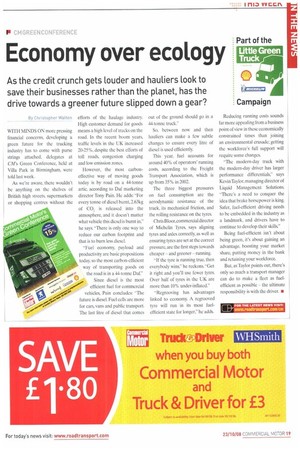Economy over ecology
Page 19

If you've noticed an error in this article please click here to report it so we can fix it.
As the credit crunch gets louder and hauliers look to save their businesses rather than the planet, has the drive towards a greener future slipped down a gear?
By Christopher Walton WITH MINDS ON more pressing financial concerns, developing a green future for the trucking industry has to come with purse strings attached, delegates at CM's Green Conference, held at Villa Park in Birmingham, were told last week.
As we're aware, there wouldn't be anything on the shelves of British high streets, supermarkets or shopping centres without the efforts of the haulage industry. High customer demand for goods means a high level of trucks on the road. In the recent boom years, traffic levels in the UK increased 20-25%, despite the best efforts of toll roads, congestion charging and low emission zones.
However, the most carboneffective way of moving goods today is by road on a 44-tonne artic, according to Dot marketing director Tony Pain. He adds: "For every tonne of diesel burnt, 2.63kg of CO, is released into the atmosphere, and it doesn't matter what vehicle this diesel is burnt in," he says. "There is only one way to reduce our carbon footprint and that is to burn less diesel.
"Fuel economy, payload and productivity are basic propositions today, so the most carbon-efficient way of transporting goods on the road is in a 44-tonne Daf." Since diesel is the most efficient fuel for commercial vehicles, Pain concludes: "The future is diesel. Fuel cells are more for cars, vans and public transport. The last litre of diesel that comes out of the ground should go in a 44-tonne truck."
So, between now and then hauliers can make a few subtle changes to ensure every litre of diesel is used efficiently.
This year, fuel accounts for around 40% of operators' running costs, according to the Freight Transport Association, which is up from 35% in 2002.
The three biggest pressures on fuel consumption are the aerodynamic resistance of the truck, its mechanical friction, and the rolling resistance on the tyres.
Chris Bloor,commercial director of Michelin Tyres, says aligning tyres and axles correctly, as well as ensuring tyres are set at the correct pressure, are the first steps towards cheaper — and greener — running.
"If the tyre is running true, then everybody wins," he reckons. "Get it right and you'll use fewer tyres. Over half of tyres in the UK are more than 10% under-inflated."
"Regrooving has advantages linked to economy. A regrooved tyre will run in its most fuelefficient state for longer," he adds. Reducing running costs sounds far more appealing from a business point of view in these economically constrained times than joining an environmental crusade: getting the workforce's full support will require some changes.
"The modern-day truck with the modern-day driver has larger performance differentials," says Kevin Taylor, managing director of Liquid Management Solutions. "There's a need to conquer the idea that brake horsepower is king. Safer, fuel-efficient driving needs to be embedded in the industry as a landmark, and drivers have to continue to develop their skills."
Being fuel-efficient isn't about being green, it's about gaining an advantage, boosting your market share, putting money in the bank and retaining your workforce.
But, as Taylor points out, there's only so much a transport manager can do to make a fleet as fuelefficient as possible — the ultimate responsibility is with the driver. •








































































































































































